Trapped in Ice
The World at the Last Glacial Maximum
Twenty-five thousand years ago, the planet was a much more forbidding place. Much of the northern hemisphere sat underneath the mile-thick ice sheets that advanced from the poles and mountain ranges. Tundra and polar desert surrounded the glaciers, rendering much of the rest of the earth less than hospitable. It was colder, on average as much as 10 degrees Fahrenheit colder than it is now, and drier. With so much water locked up in permanent ice sheets, sea levels dropped, exposing huge areas of continental shelf. The trees retreated. Open, sprawling grasslands replaced forest across the northern reaches of the globe, places where chilly wind howled amid the herds of reindeer, mammoth, and bison, where lions and sabertooth tigers and giant wolves stalked the big grazers.
For most of the past 115,000 years, the planet has cooled and warmed, warmed and cooled, but always erred toward the colder side. This was the environment into which Homo sapiens emerged in Eurasia. Not only did anatomically modern humans survive these extremes of ice, desert, and wind; our ancestors thrived there, spreading out across the planet to populate its furthest reaches.
The ice reached its greatest extent between about 26,000 and 20,000 years ago. This was the Last Glacial Maximum, the stretch of time when the planet was at its coldest, the glaciers pushed the furthest, the sea levels were lowest, and humans retreated from their northern outposts and settled into safe refuges in the south. Our archaic cousins like Neanderthals and Denisovans were almost all gone, either died out or absorbed into the ranks of modern humans, leaving behind only faint traces in the genes of their successors. But by that point, Homo sapiens - with a little help from our extinct relatives - had already established itself everywhere from southern Africa to Siberia and Australia.
Who were these people, these inhabitants of a hard and varied land? How, exactly, did they migrate and prosper amid an environment that seems so antithetical to human life? And what were their lives like?
Let’s start by taking a look at the landscape. This is the mammoth steppe, the world’s most common biome (environment) around the time of the Last Glacial Maximum:
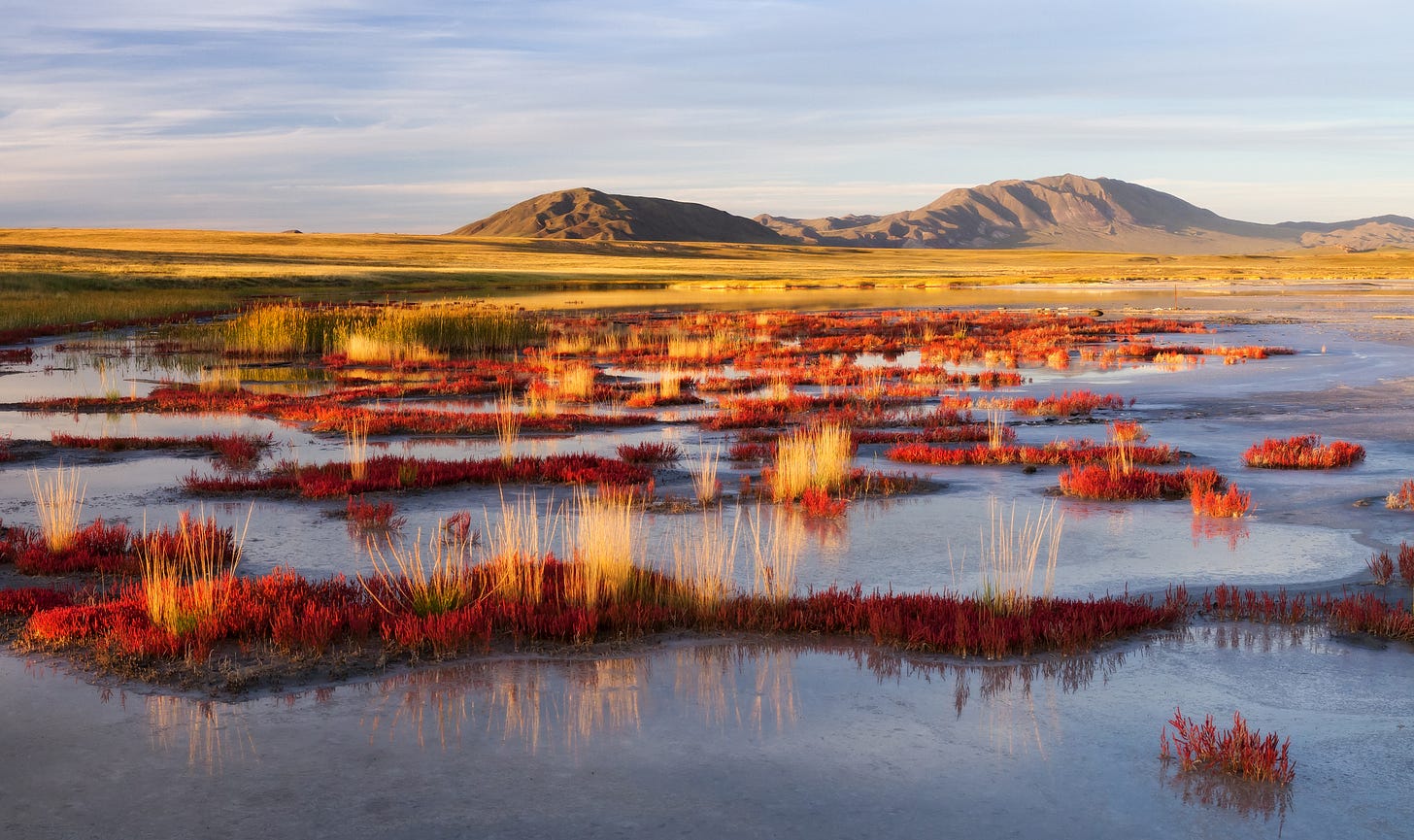
Mammoth steppe featured a mixture of highly productive grasses, shrubs, and flowering plants. This flora supported herds of large grazers that constantly broke up the snow and ice, fostering the growth of the very plants on which the grazers relied. Mammoth, bison, aurochs (wild cattle), wild horses, reindeer, woolly rhinoceros, and a vast array of other animal life flourished there. So too did humans. This was less an arctic desert than a grassland, more like a colder, dryer Serengeti than tundra. Outside some limited areas along the border between Siberia and Mongolia near the Altai Mountains, remnants whose climate has barely changed since the Last Glacial Maximum, it’s a biome that essentially no longer exists today.
But mammoth steppe once existed everywhere from France to Siberia and beyond. The first migrants to the Americas lived in the mammoth steppe’s heartland in Beringia, the vast region connecting Siberia to Alaska and the Yukon that is now underneath the Bering Strait. The ancestors of the first Americans hunted mammoth, elk, and bison in Beringia; at the same time, the inhabitants of what’s now central France and western Germany ambushed herds of reindeer in river valleys. Small bands of hunter-gatherers fanned out across the mammoth steppe and the other productive grasslands of Eurasia and beyond.
By 20,000 years before the present, these hunter-gatherers had already been at it for a long time. Their ancestors - the people who contributed the vast majority of ancestry to all non-Africans today, and to many of those living inside our home continent - had first left Africa as early as 210,000 years ago; a skull dated to that period from a cave in Greece would seem to be the earliest evidence of Homo sapiens in Eurasia. Assuming this identification is correct, however, the group to whom this person belongs died out, leaving no trace on those who came later. The same seems to have been true of the Homo sapiens who took up residence in what’s now the Levant, particularly Israel, more than 100,000 years ago. One of these waves of early Homo sapiens migration might have left a tiny trace in the ancestry of later Neanderthals, who carried a little bit of our ancestry in the same way that we now carry theirs.
But at some point between 60,000 and 100,000 years ago, a group grew isolated from the rest of the human population. Its descendants left Africa and found more success than their predecessors. Precisely where they lived is unclear - my personal guess is Arabia, which was then covered in savannas, grasslands, and river valleys rather than sparse desert - but they stuck around as a population for tens of thousands of years. And then, in the relative blink of an eye (between about 60,000 and 50,000 years ago), they seem to have developed a real sense of wanderlust. This group branched into several splinter populations, which grew isolated from one another for thousands of years and then proceeded to interbreed with a variety of archaic human species (Neanderthals, Denisovans, Neanderthals again, Denisovans again, etc.) on their way to populating the rest of the globe. Before too long, there were anatomically modern humans in Europe, Siberia, East Asia, southeast Asia, and Australia. Only the Americas remained out of reach, at least for the moment.
The ancient DNA recovered from people who lived tens of thousands of years ago is the key to understanding these complex but small-scale population movements. The people of the Paleolithic - the Old Stone Age - lived, thrived, met one another, and interbred. Some of these groups, presumably most of them, died out and left no descendants who have made it to the present. The young man from Peștera cu Oase in Romania, who had a Neanderthal ancestor within the past few generations around 40,000 years ago, belonged to one of these dead-end groups:
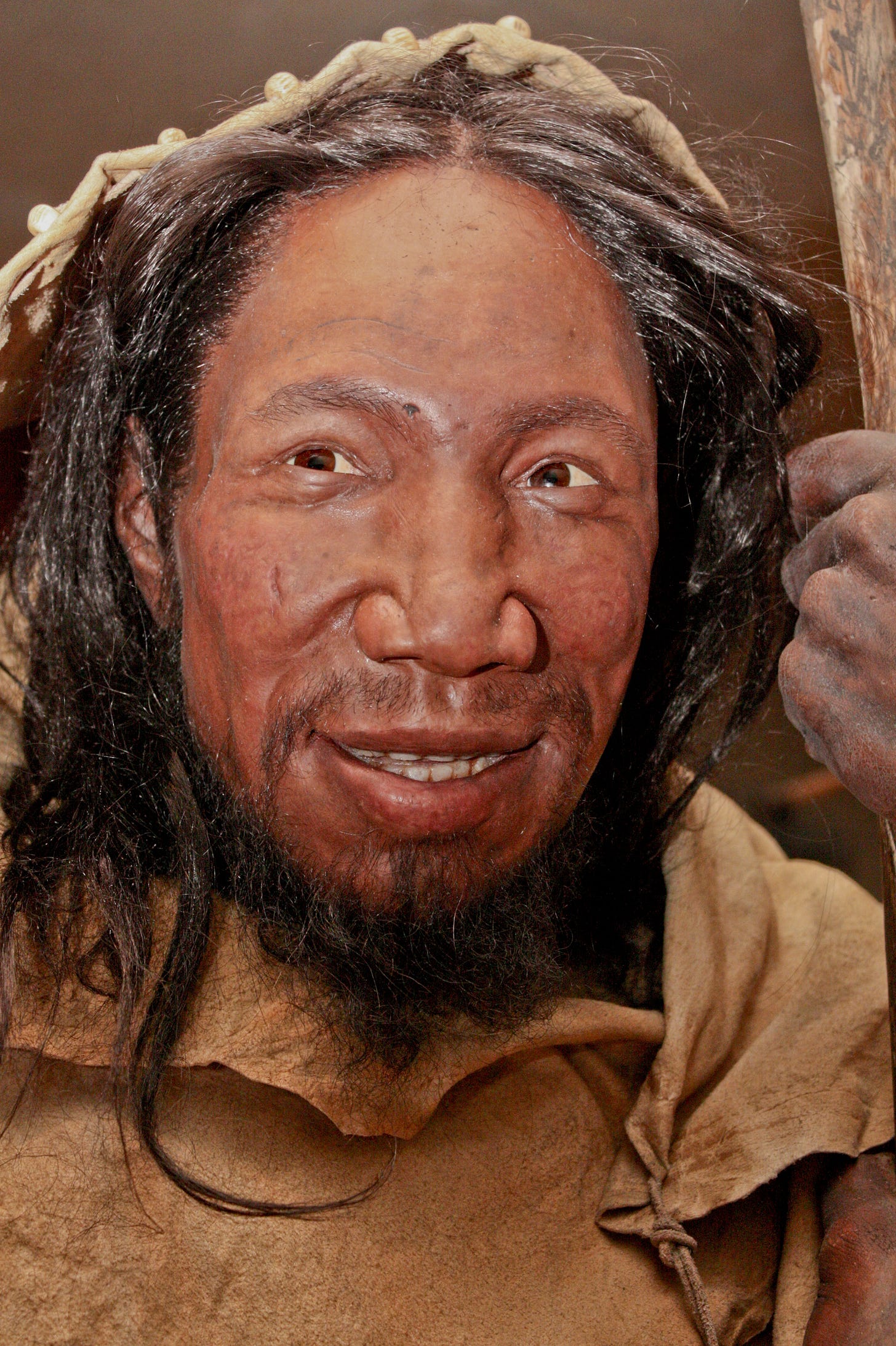
Over time, these groups came together and split apart, over and over and over. We have to imagine small bands of perhaps 25 to 100 people ranging across an enormous and sparsely populated landscape, maintaining contact with a few other similar bands. It would have been easy for one of these small groups to fall victim to a terrible storm, a famine, or a new disease, dying out for good and bringing thousands of years of genetic history to an end.
While their lives were hard, these were sophisticated and intelligent people, no less cognitively capable than modern humans today. They made a variety of increasingly complex tools from stone, bone, and antler, hunted cooperatively, and made music. Archaeologists have found flutes made from animal bone:

They play a haunting melody:
But this was only the surface of their artistic tradition. Paleolithic people made incredible visual art. Much of it was portable - figurines, jewelry, etc. - but the most stunning pieces were painted, drawn, and carved on the walls of caves. This way of making art, and presumably the underlying impulses and needs it met, lasted for tens of thousands of years. Let’s check out a few images.
The Panel of the Lions, from Chauvet Cave in France (c. 36,000-28,000 years before present)
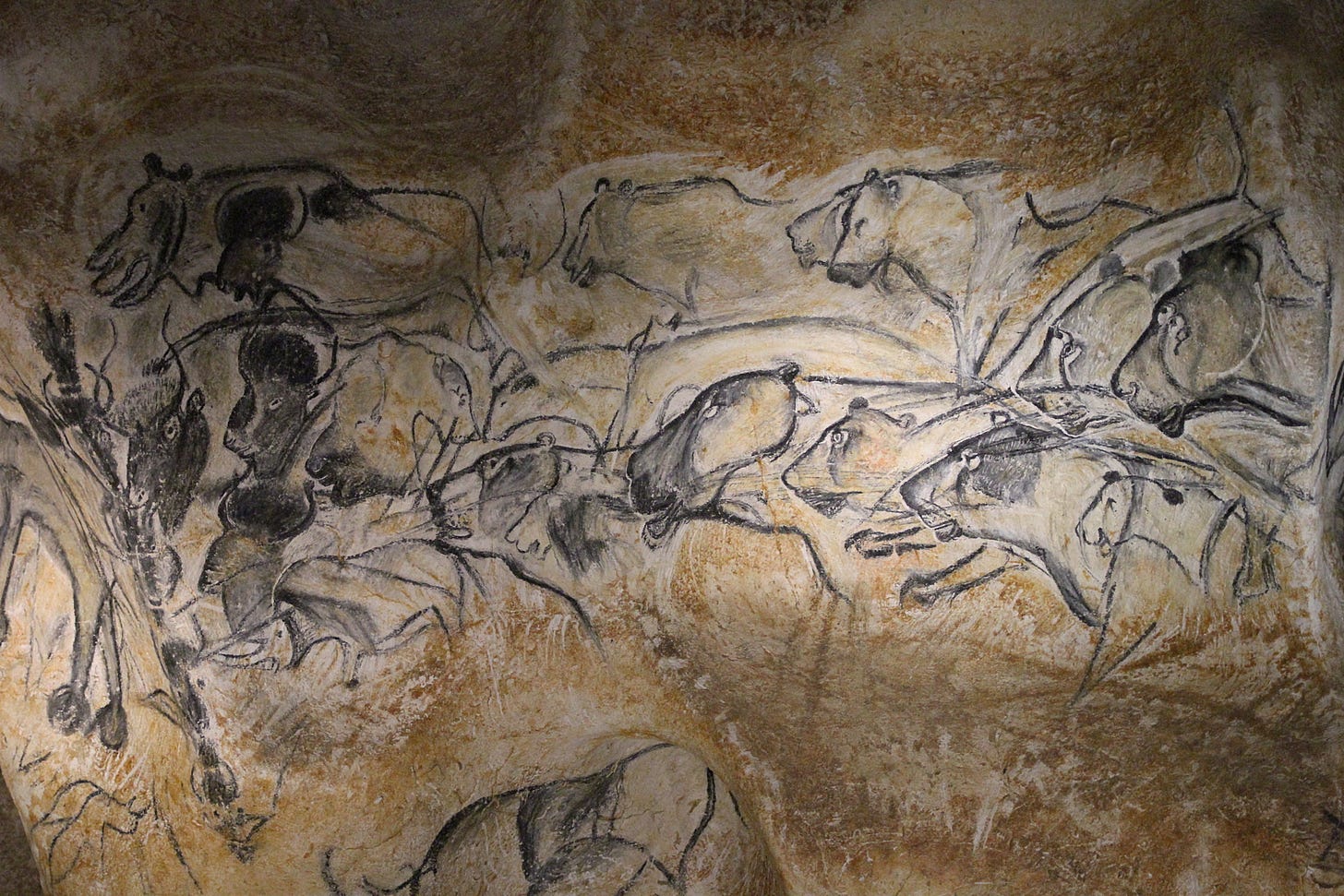
Horses, aurochs, and rhinoceros from Chauvet:
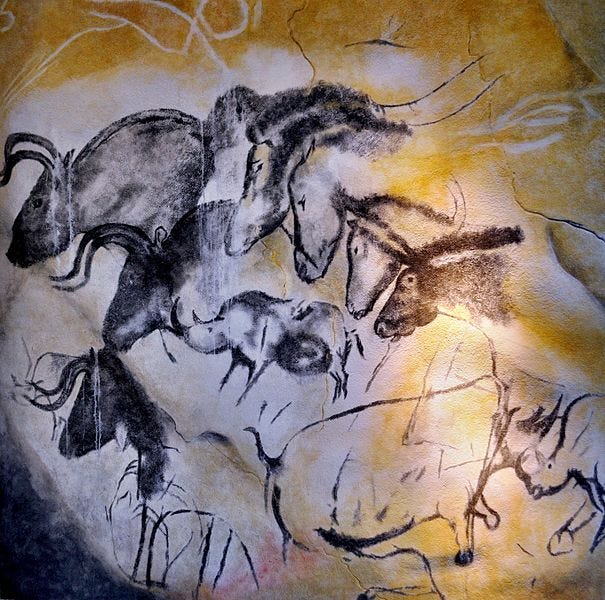
Bison, from Altamira Cave in Spain (c. 36,000-22,000 years before present)
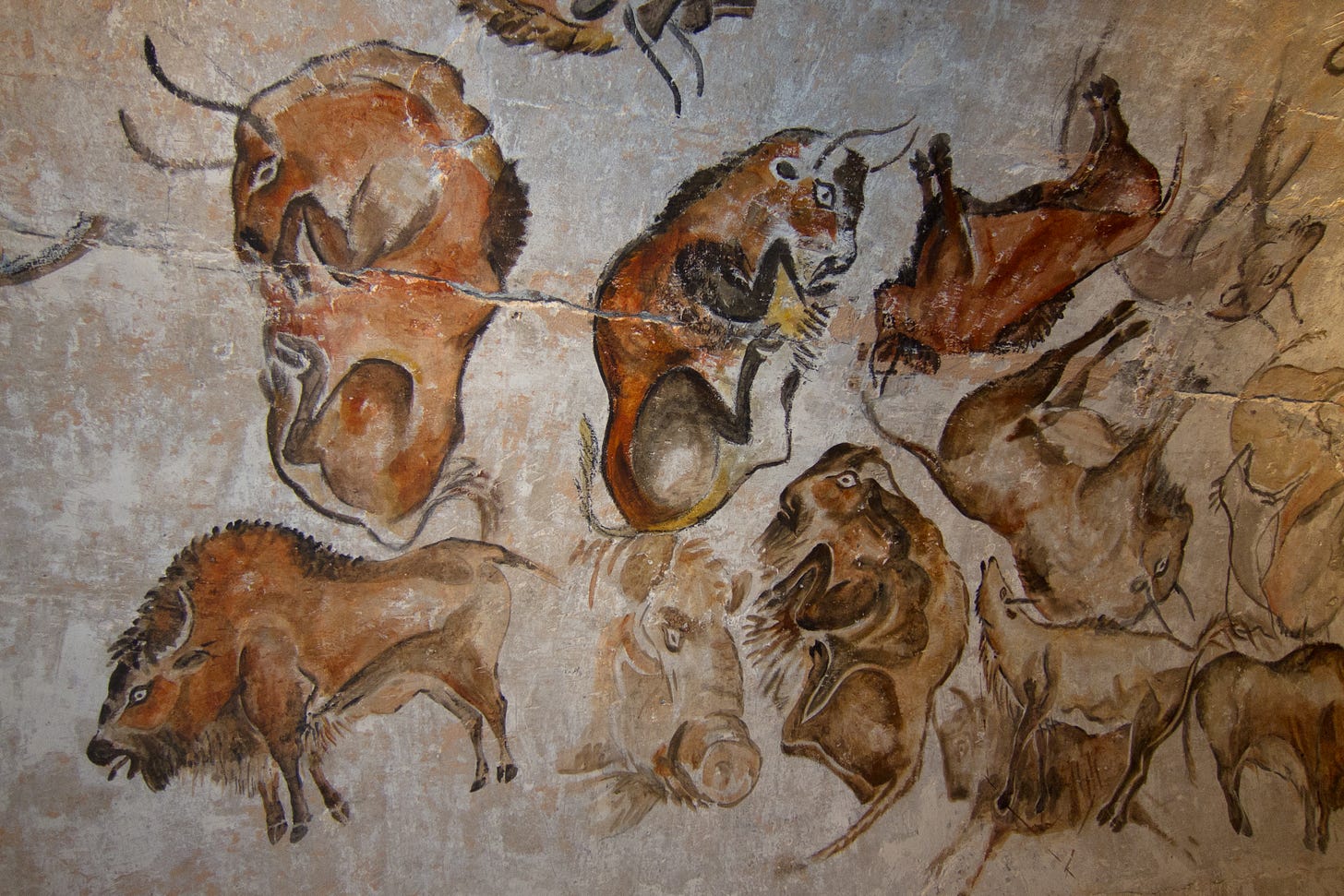
Megaloceros, or giant elk, from Lascaux in France (c. 17,000 years before present)
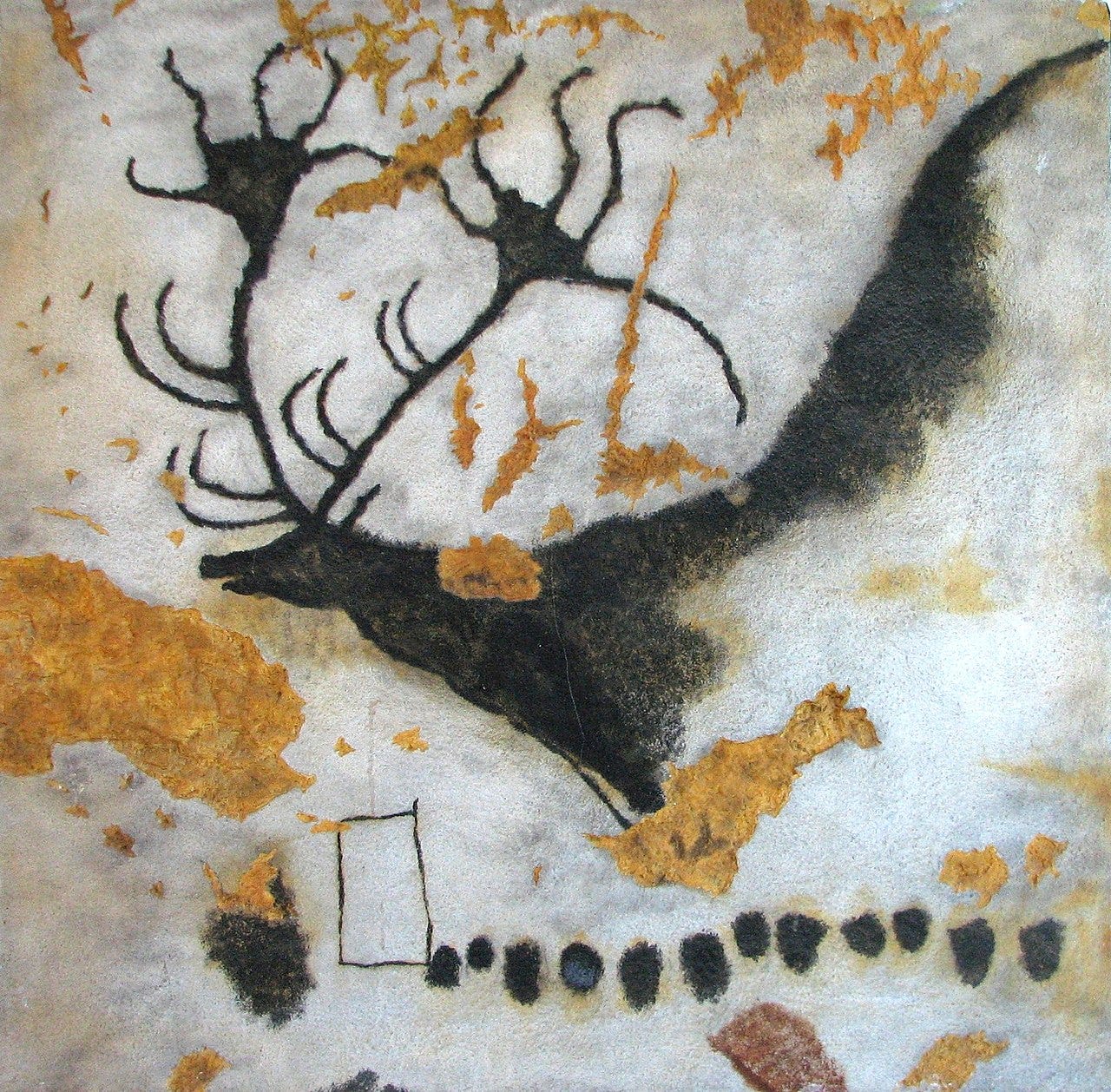
These are, to put it mildly, masterpieces. We have to imagine the torchlight flickering off the images in the darkness of the cave, music, chanting, dancing, simulations of animal noise echoing through the galleries. It would’ve seemed like they were moving, maybe even alive.
Anyway, I think this stuff is pretty neat: a coherent artistic tradition that lasted for tens of thousands of years across huge distances of time and space.
If you’d like to learn more about Paleolithic art and the people who made it, check out the most recent episode of Tides of History, my podcast. If you like it, subscribe on the platform of your choice. And if you like these essays and posts, be sure to subscribe to this newsletter as well.
Bibliography:
Steven Mithen, After the Ice: A Global Human History, 20,000-5000 BC
David Reich, Who We Are and How We Got Here: Ancient DNA and the New Science of the Human Past
Ross D.E. MacPhee, End of the Megafauna: The World’s Hugest, Fiercest, and Strangest Animals
Paul G. Bahn, Images of the Ice Age

The picture of the Mammoth steppe is very compelling. Where did it come from? Thanks!
Hi, do you have a family tree that puts all the different modern human ancestors found on their respective branches?